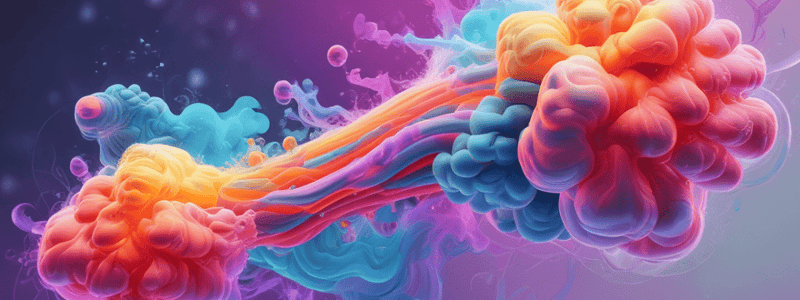Podcast
Questions and Answers
What is the primary driving force for the diffusion of oxygen from the alveoli into the pulmonary capillary blood?
What is the primary driving force for the diffusion of oxygen from the alveoli into the pulmonary capillary blood?
- The higher partial pressure of oxygen in the alveoli compared to the pulmonary capillary blood. (correct)
- The lower partial pressure of oxygen in the alveoli compared to the pulmonary capillary blood.
- The higher partial pressure of carbon dioxide in the alveoli compared to the pulmonary capillary blood.
- The lower partial pressure of carbon dioxide in the alveoli compared to the pulmonary capillary blood.
Which of the following best describes the transport of oxygen in the blood from the lungs to the tissues?
Which of the following best describes the transport of oxygen in the blood from the lungs to the tissues?
- Oxygen is transported in the blood in all three forms: dissolved, bound to hemoglobin, and as bicarbonate ions.
- Oxygen is transported in the blood bound to hemoglobin. (correct)
- Oxygen is transported in the blood as bicarbonate ions.
- Oxygen is transported in the plasma as a dissolved gas.
What is the primary driving force for the diffusion of carbon dioxide from the tissues into the blood?
What is the primary driving force for the diffusion of carbon dioxide from the tissues into the blood?
- The higher partial pressure of oxygen in the tissues compared to the blood.
- The lower partial pressure of oxygen in the tissues compared to the blood.
- The higher partial pressure of carbon dioxide in the tissues compared to the blood. (correct)
- The lower partial pressure of carbon dioxide in the tissues compared to the blood.
How is carbon dioxide transported in the blood from the tissues to the lungs?
How is carbon dioxide transported in the blood from the tissues to the lungs?
What is the primary mechanism of oxygen unloading from hemoglobin in the tissues?
What is the primary mechanism of oxygen unloading from hemoglobin in the tissues?
What is the term used to describe the exchange of gases between the air in the alveoli and the blood in the pulmonary capillaries?
What is the term used to describe the exchange of gases between the air in the alveoli and the blood in the pulmonary capillaries?
What is the primary mechanism of carbon dioxide diffusion from the pulmonary capillary blood into the alveoli?
What is the primary mechanism of carbon dioxide diffusion from the pulmonary capillary blood into the alveoli?
Which enzyme facilitates the breakdown of carbonic acid in red blood cells?
Which enzyme facilitates the breakdown of carbonic acid in red blood cells?
What is the term used to describe the exchange of gases between the blood and the tissues?
What is the term used to describe the exchange of gases between the blood and the tissues?
What is the primary cause of altitude sickness?
What is the primary cause of altitude sickness?
What is the term used to describe the condition where the amount of oxygen available for cellular metabolism is inadequate?
What is the term used to describe the condition where the amount of oxygen available for cellular metabolism is inadequate?
What is the term used to describe the purplish discoloration seen on the mucous membranes, fingertips, and toes due to hypoxemic blood?
What is the term used to describe the purplish discoloration seen on the mucous membranes, fingertips, and toes due to hypoxemic blood?
What is the term used to describe the increased production of red blood cells in response to chronic hypoxemia?
What is the term used to describe the increased production of red blood cells in response to chronic hypoxemia?
What is the primary purpose of the polycythemia that results from chronic hypoxemia?
What is the primary purpose of the polycythemia that results from chronic hypoxemia?
What is the term used to describe the body's process of adjusting to high altitude conditions?
What is the term used to describe the body's process of adjusting to high altitude conditions?
Flashcards are hidden until you start studying
Study Notes
Oxygen Transport
- Oxygen diffuses from the alveoli into the pulmonary capillary blood in the lungs due to the higher oxygen partial pressure (PO2) in the alveoli.
- In the tissues, oxygen diffuses from the capillary blood into the surrounding cells due to the higher PO2 in the capillary blood compared to the tissues.
- Oxygen is carried in the blood by binding loosely and reversibly with the heme portion of hemoglobin.
- When PO2 is high, oxygen binds with hemoglobin, but when PO2 is low, oxygen is released from hemoglobin.
Carbon Dioxide Transport
- Carbon dioxide diffuses from the tissues into the blood due to the higher PCO2 in the tissues.
- In the lungs, CO2 diffuses from the pulmonary capillary blood into the alveoli due to the higher PCO2 in the pulmonary capillary blood.
- CO2 is carried in the blood in three forms: bicarbonate ions (HCO3-), bound to hemoglobin, and dissolved in plasma.
- The enzyme carbonic anhydrase speeds the breakdown of carbonic acid (H2CO3) in red blood cells.
External Respiration
- External respiration is the exchange of gases between air in the alveoli and blood in the pulmonary capillaries.
Internal Respiration
- Internal respiration is the exchange of gases between the blood and the tissues.
Altitude Sickness and Acclimatisation
- Altitude sickness is caused by acute exposure to low partial pressure of oxygen at high altitude.
- The body compensates for altitude sickness through altitude acclimatisation, which involves producing more red blood cells.
Tissue Hypoxia and Cyanosis
- Tissue hypoxia occurs when the amount of oxygen available for cellular metabolism is inadequate.
- Hypoxia leads to anaerobic mechanisms that produce lactic acid and decrease blood pH.
- Cyanosis is a purplish discoloration seen on the mucous membranes, fingertips, and toes when the blood in these areas is hypoxemic.
Polycythemia
- Polycythemia occurs when pulmonary disorders produce chronic hypoxemia, leading to an increased level of RBCs.
- The hormone erythropoietin stimulates the bone marrow to increase RBC production in response to hypoxemia.
- Polycythemia is an adaptive mechanism designed to increase the oxygen-carrying capacity of the blood.
Studying That Suits You
Use AI to generate personalized quizzes and flashcards to suit your learning preferences.




